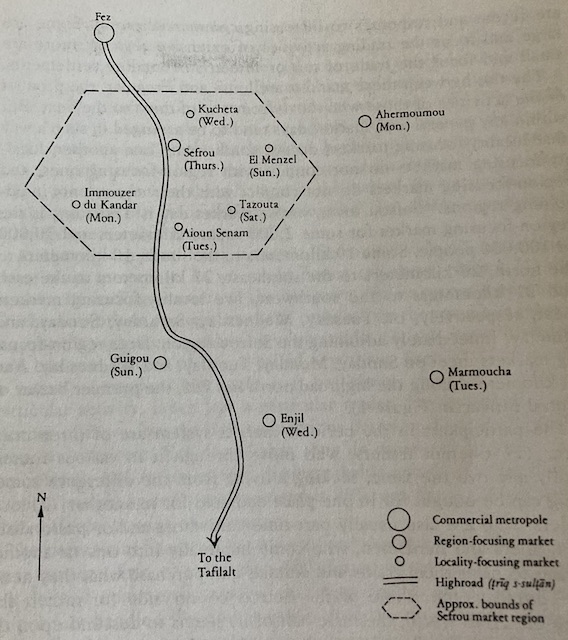The Sunday Market of Guigou
Above is a short film we made of visiting the market of Guigou. For the narration of the video, I used material from the celebrated Sefrou anthropologist, Professor Clifford Geertz. Below is the extract from Geertz that I used:
The term for both market and marketplace in Sefrou, as in the Arab world generally, is sūq. The term can be applied to a market centre as a whole, as in sūq S-Sefrū (the Sefrou market); to a specialized marketplace, as in sūq l-behāyim (the animal market); to the part of a quarter that is commercial as opposed to residential (i.e., as a place name), as in Bistna Suq, Bistna being the name of a quarter; to a commodity market considered analytically, as in sūq l-fūl (the bean trade); for a market day, as in suq l-kemīs (the Thursday market).
Sefrouis divide the bazaar into three main sectors, or realms:
(1) The permanent bazaar of the old city. This is home to more than 600 shops, representing about 40 well-defined commercial trades, each specifically named in terms of the product handled. In addition to the shops there are nearly 300 craft ateliers, representing about 30 distinct crafts. On top of this, there are a significant number of people whose activities seem to fall mainly within the realm of the bazaar, but who are not housed in a shop or atelier: auctioneers, brokers of various sorts, ‘footloose’ craftsmen such as masons or tile layers, curers, scribes, musicians, porters, keepers of caravanserais, bath attendants, prostitutes, street peddlers, buttonmakers. Taken together these permanent bazaar occupations account for around 40 to 50 percent of town’s employed labour force.
(2) The network of periodic markets, centered on the town but spreading out through the neighbouring countryside. This network consists of a cloud of open-air markets scattered more or less continuously across the whole of Morocco, each of which meets once a week. Sefrou town, whose market day is Thursday, is the region-focusing market for some 2,000 square kilometres and 90,000 or 100,000 people. Some 19km to the south, 10 km to the north, 26 km to the southeast, 27km to the east, and 21km to the southwest, five locality-focusing markets meet, respectively, on Tuesday, Wednesday, Saturday, Sunday, and Monday. Immediately adjoining the Sefrou region, large region-focusing markets meet on Sunday, Monday, Tuesday, and Wednesday.

One of these large region-focusing markets, 60km from Sefrou, is Guigou. It meets on a Sunday.
The participants in the periodic market system are of three main sorts: (1) itinerant traders, who move through it in various routes, hardly any two the same, seeking a living from the difference something can be bought for in one place and sold for in another; (2) local traders, who are also usually part-time cultivators and/or pastoralists; (3) farmers and herdsmen, who come habitually into one or another market to offer their grains and animals and purchase what they need. On Thursday, the whole of the Sefrou countryside seems to descend upon the town to buy and sell grain, wool, animals, rugs, fruits, and vegetables, wickerwork, household equipment, and various sorts of secondhand objects in the locations specialized for trade in these commodities established at various points around the perimeter of the town, while from all directions of the compass (including, of course, from Sefrou itself) professional traders come to meet them there. Some idea of the scale of market day in Sefrou is given by the fact that in 1965 about 50,000 animals (an average of 1,000 a week) changed hands in the Thursday market.
(3) The more Westernised business district of the so-called new town.
